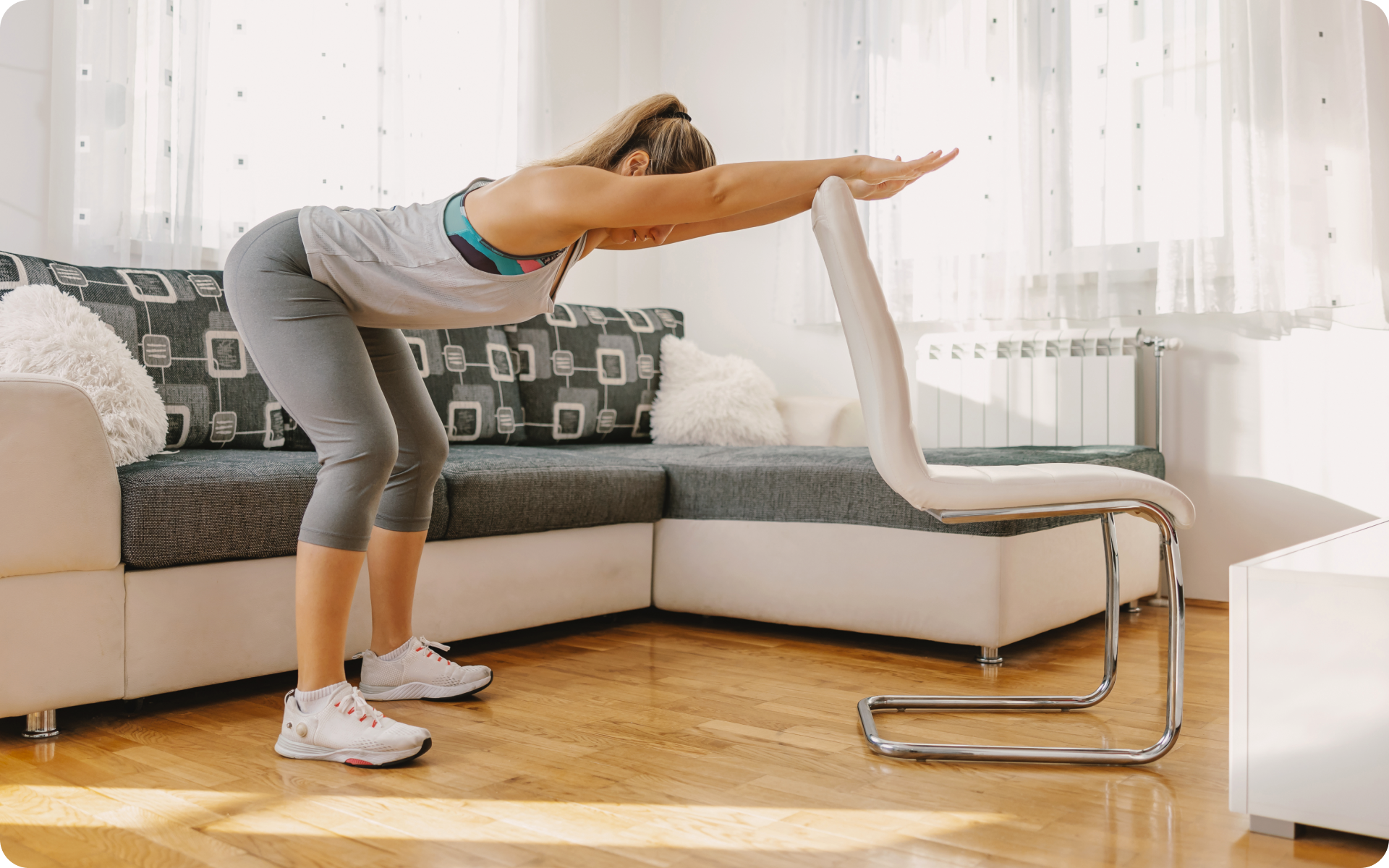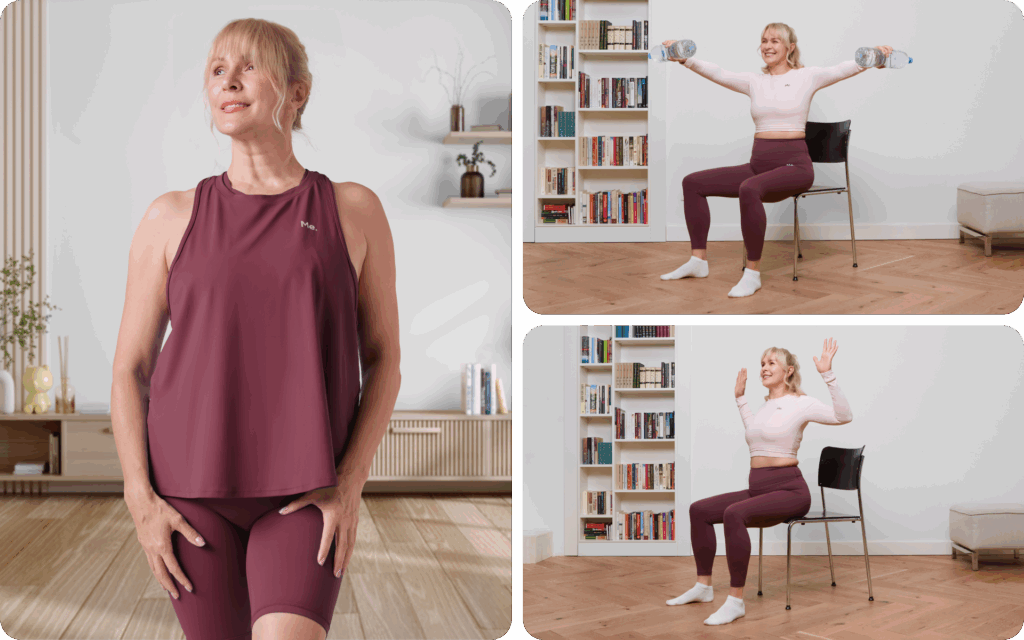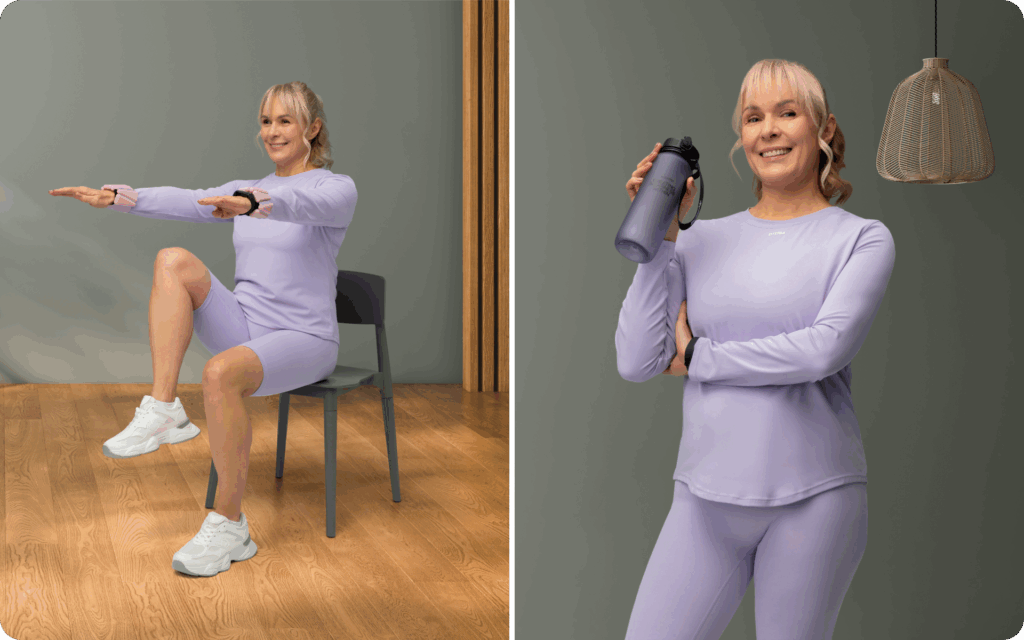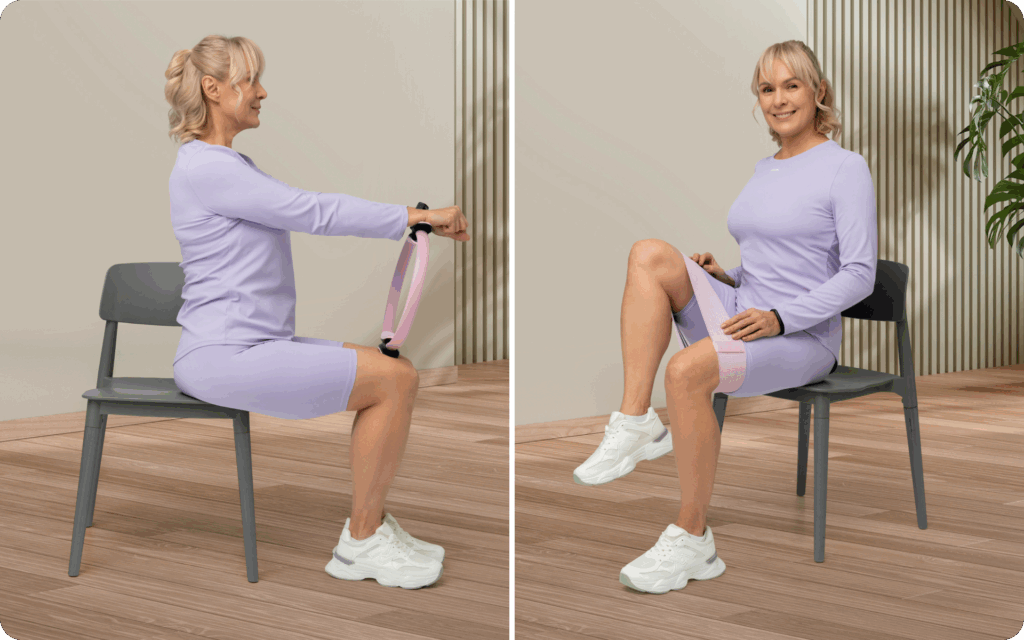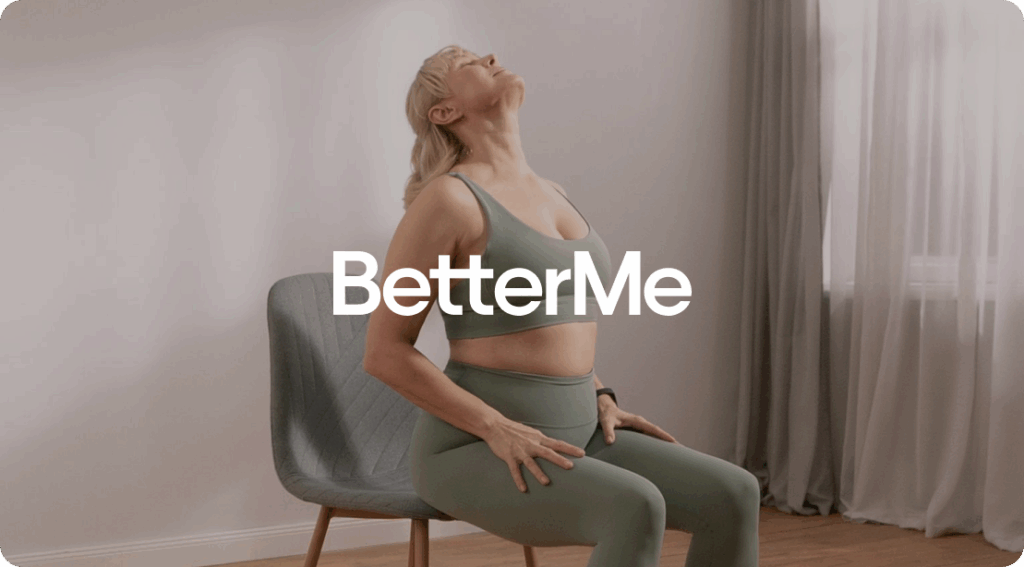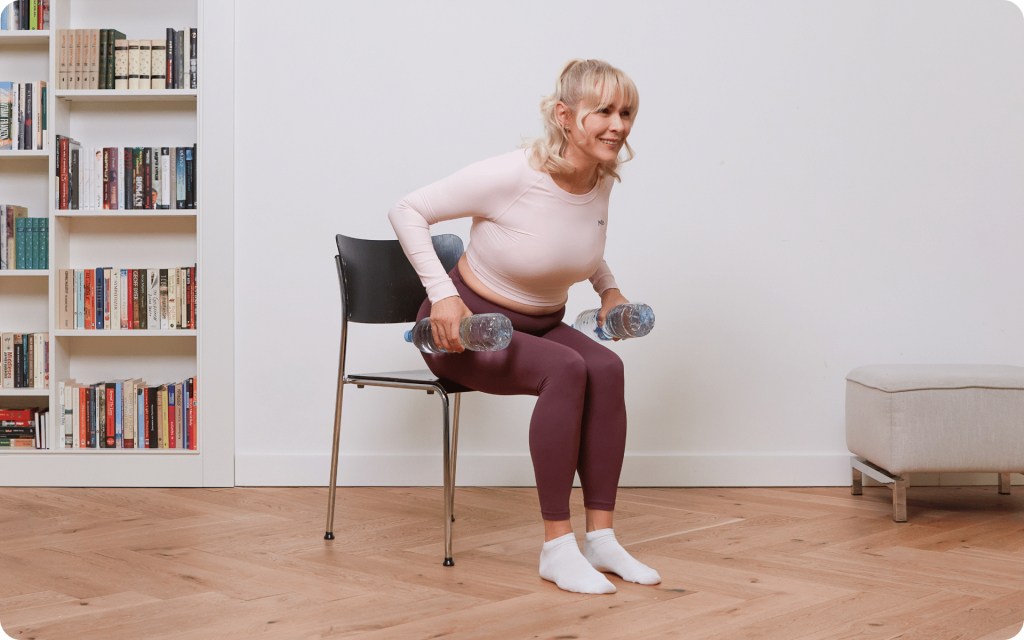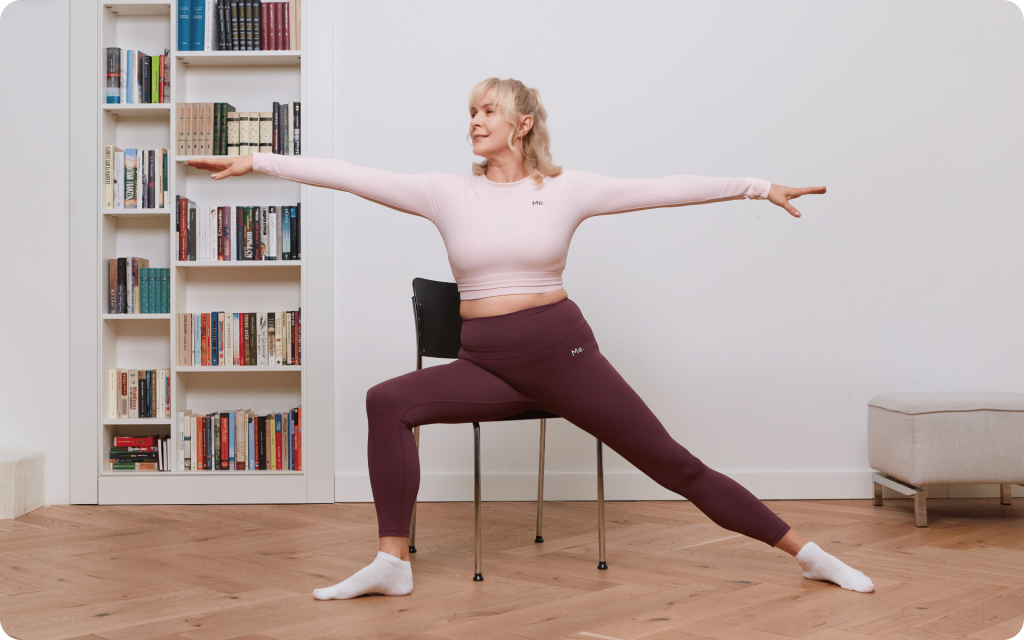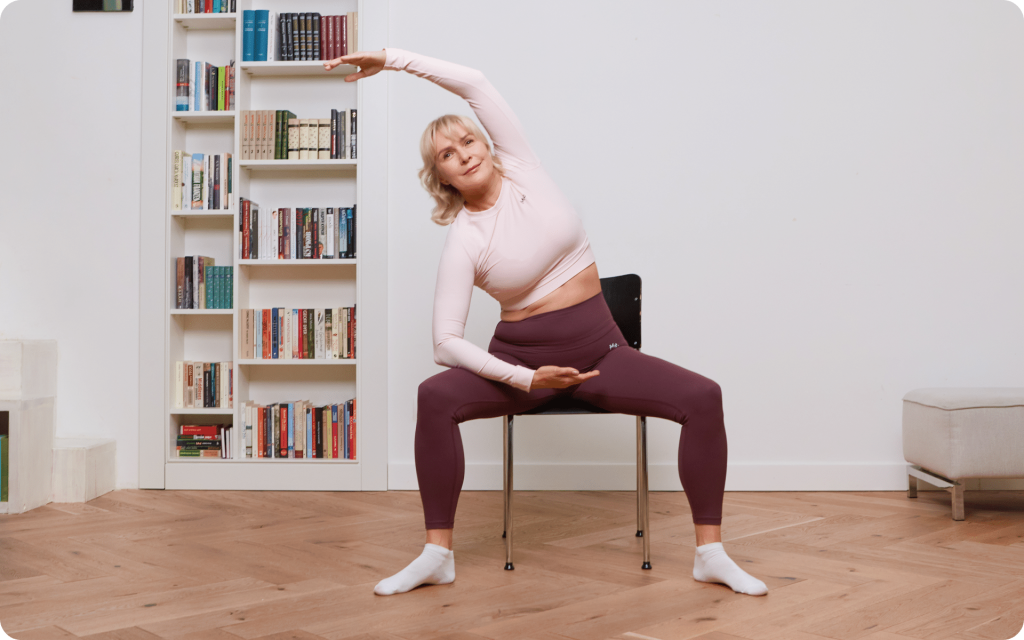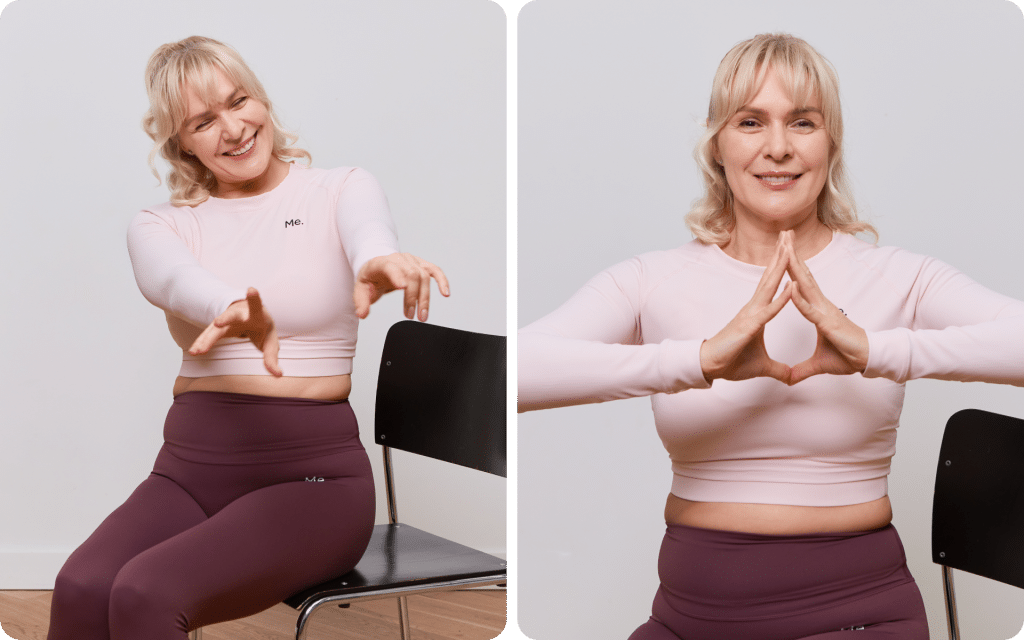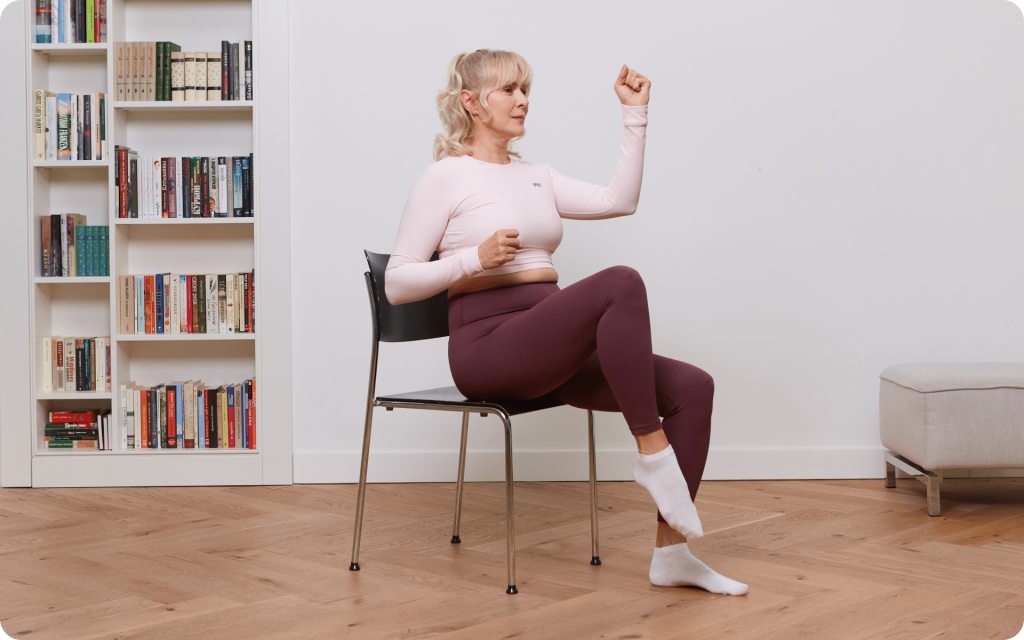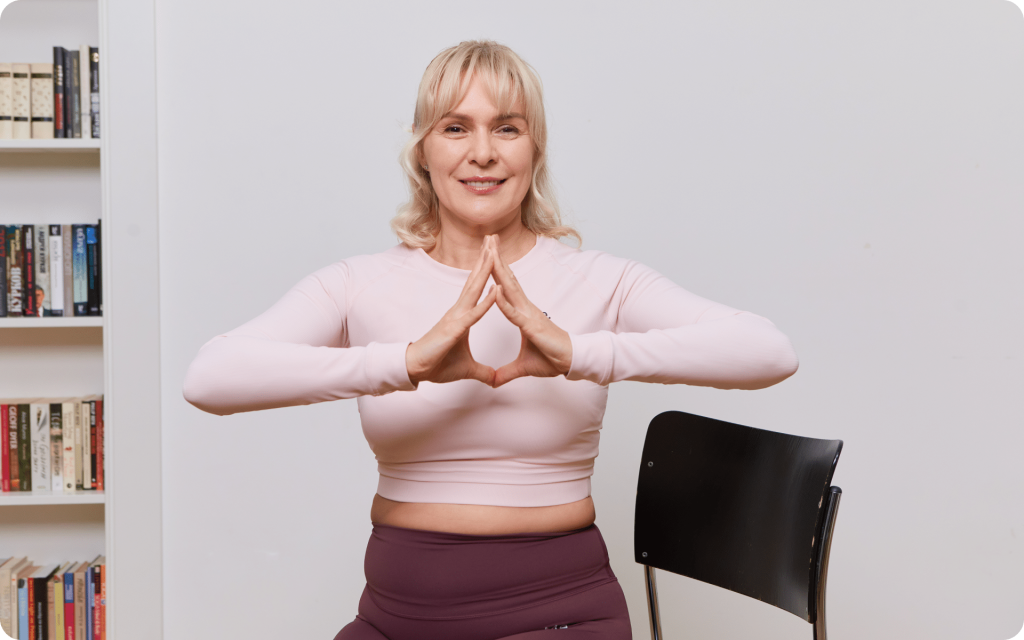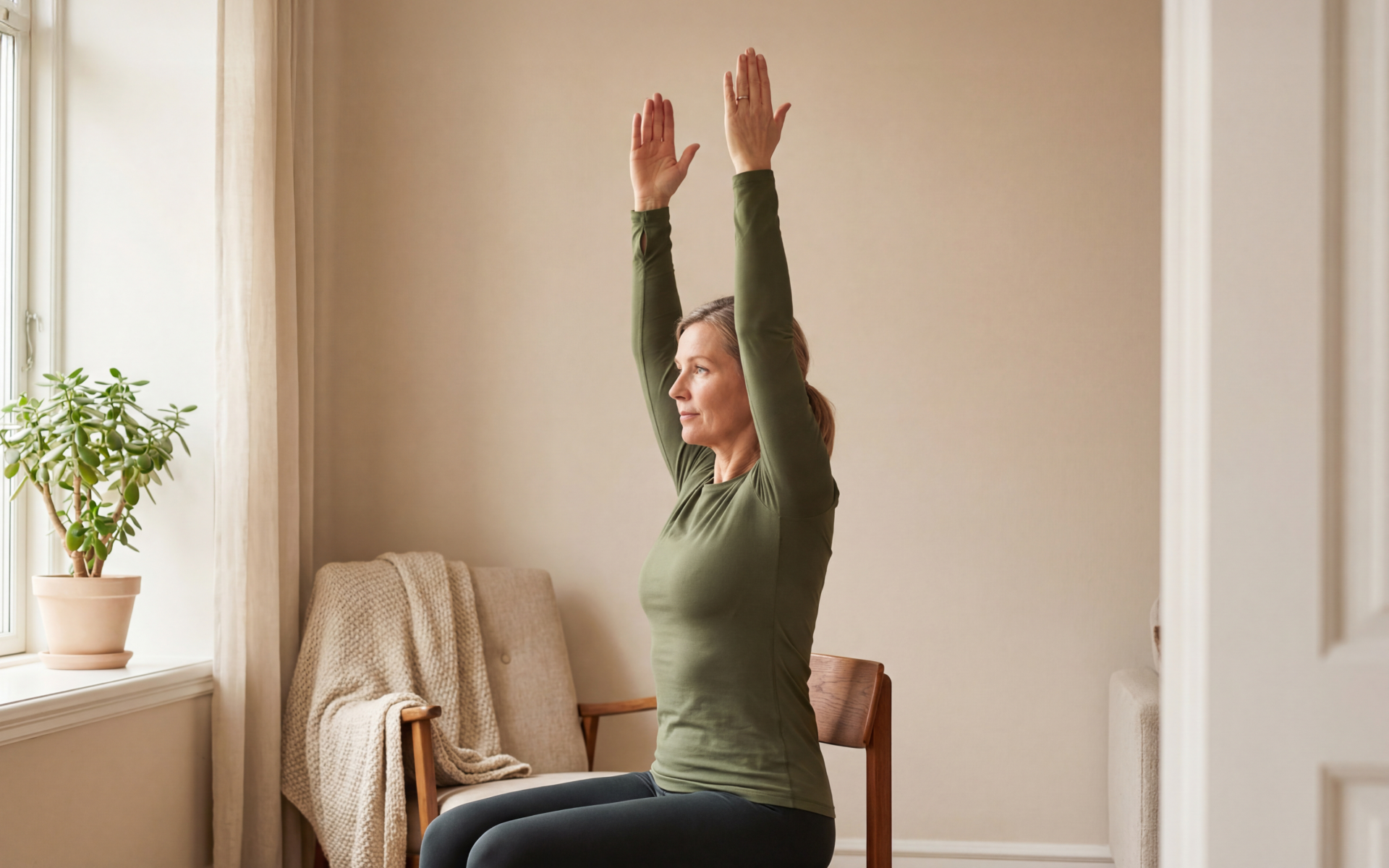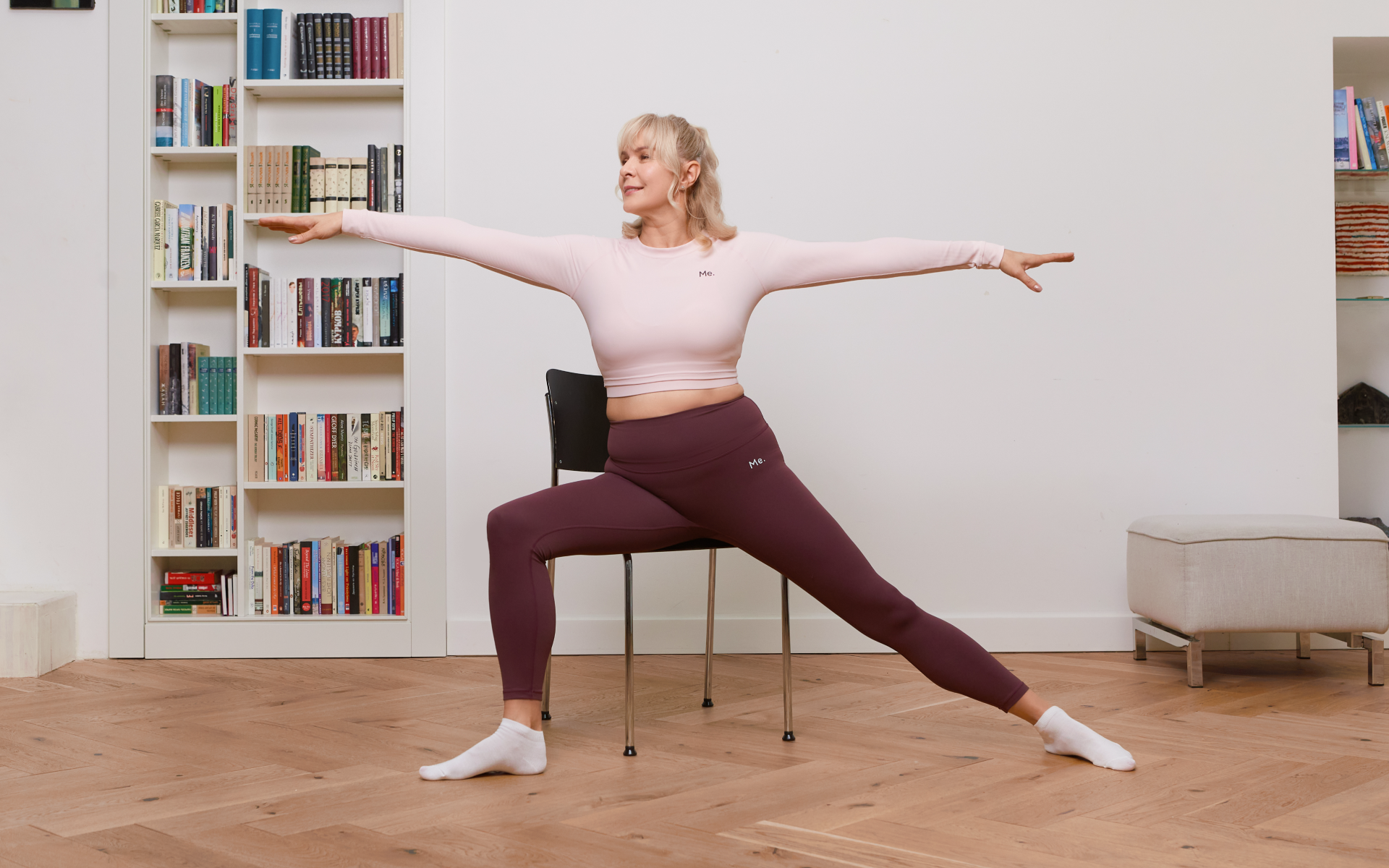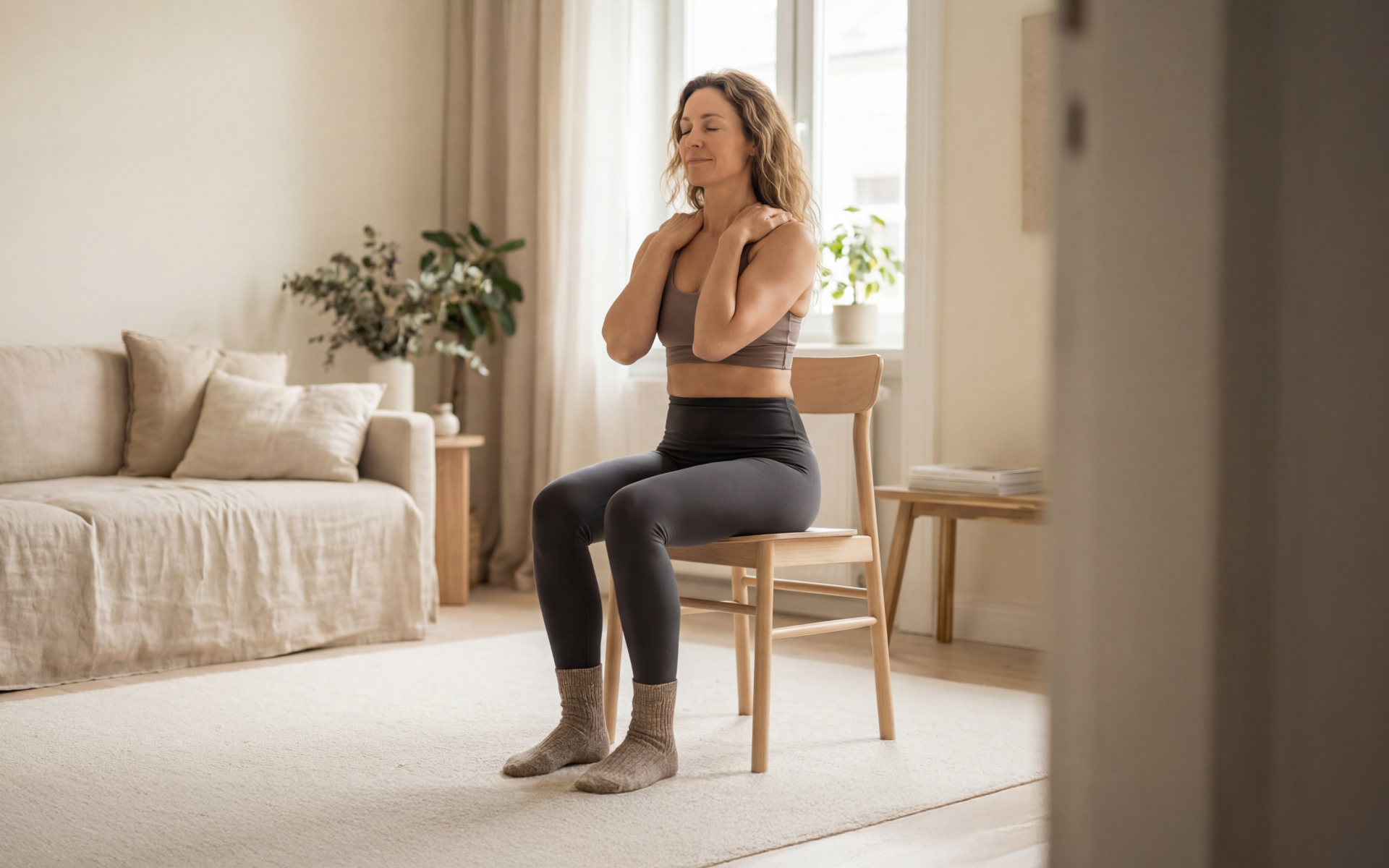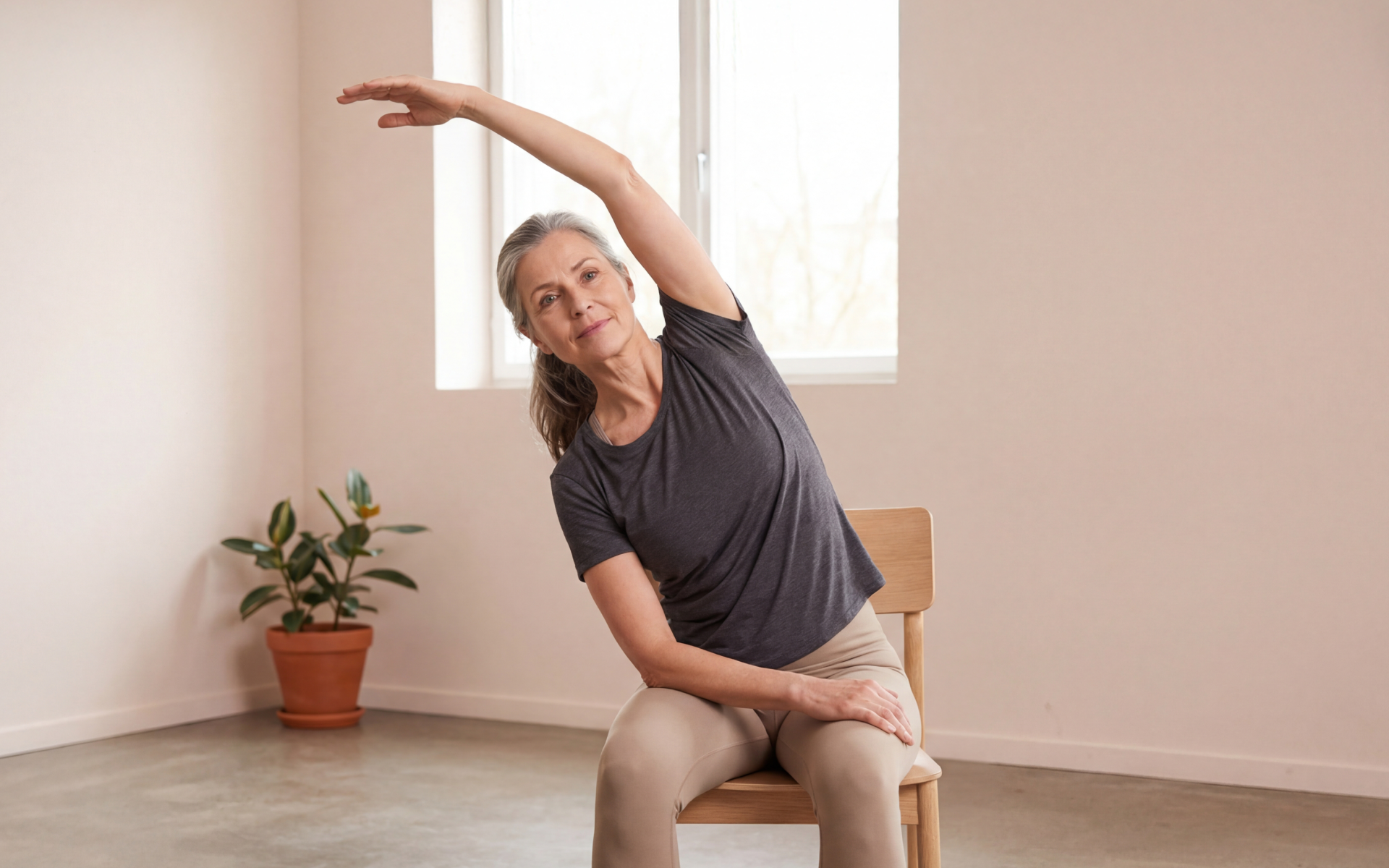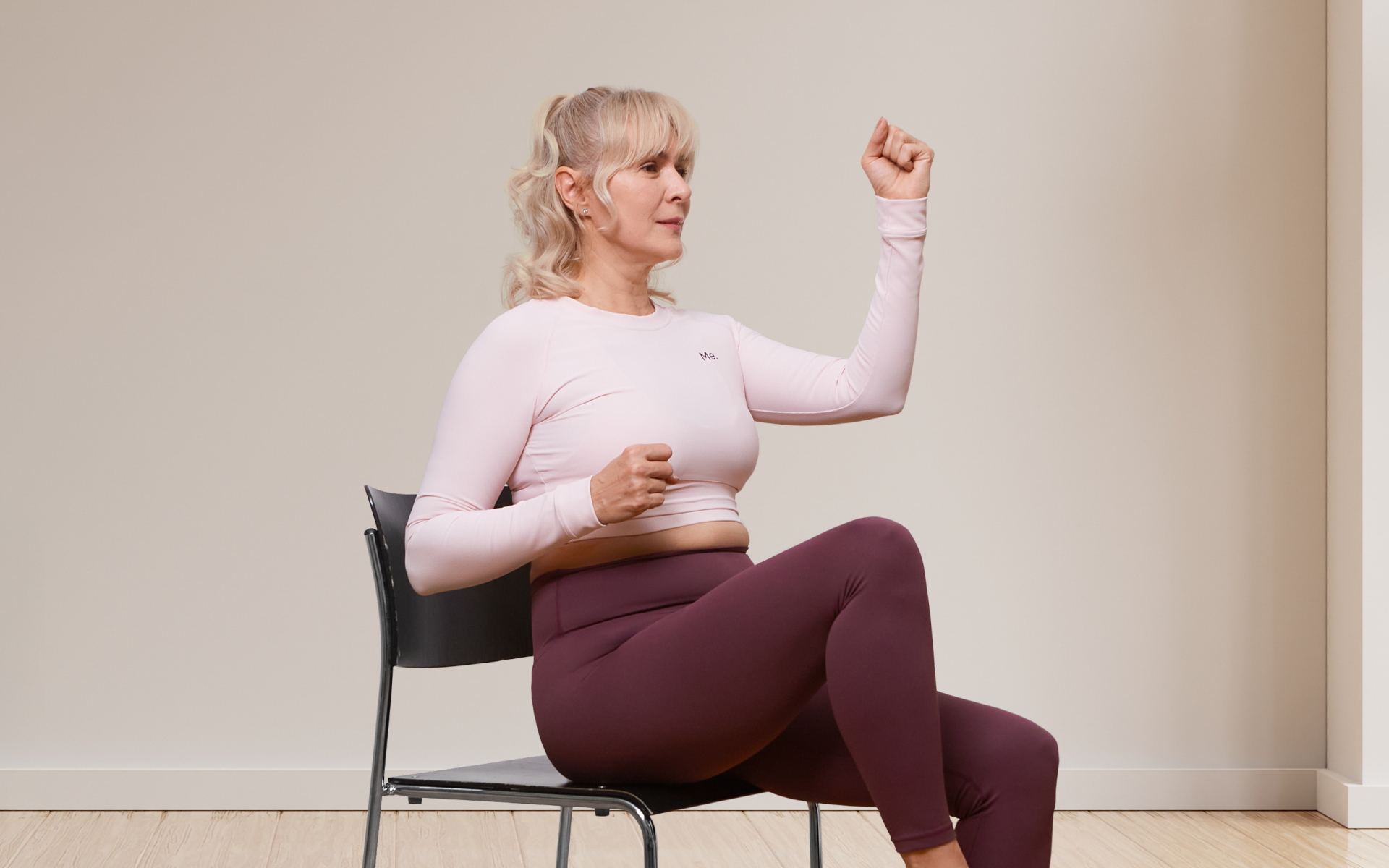Chair yoga transforms traditional yoga practice into an accessible format that anyone can embrace. The beauty of chair yoga lies in its adaptability.
This gentle approach removes common barriers like mobility limitations, balance concerns, or floor-based movements while maintaining the core benefits of yoga practice. These include the same mindful breathing, gentle stretching, and mind-body connection.
The chair simply serves as your foundation and support system.
This comprehensive guide will walk you through everything you need to know about chair yoga for beginners. You’ll discover which poses work best for newcomers, learn proper execution techniques, and understand how to build a sustainable practice that fits your lifestyle and physical capabilities.
Which Is The Easiest Yoga For Beginners?
Many wonder, “What are simple chair yoga poses for beginners?
It makes sense to start with what is easy.
However, the concept of “easy” in yoga extends beyond simple physical movements.
True ease comes from finding a practice that matches your current abilities while providing room for growth.
Chair yoga consistently ranks as the most accessible entry point for yoga beginners.
The chair provides stable support, eliminating the need for balance or core strength that floor-based poses often require.
This stability allows you to focus entirely on factors that help build awareness:
- Breathing
- Alignment
- Subtle movements.
Unlike standing poses that challenge your balance or floor sequences that require getting up and down repeatedly, chair yoga maintains a consistent base of support.
You can modify the intensity of each pose simply by adjusting how deeply you stretch or how long you hold the position.
The seated position also removes intimidation factors that often discourage beginners.
There’s no concern about:
- Falling
- Struggling to get up from the floor
- Feeling exposed in vulnerable positions
This psychological comfort creates space for genuine exploration and learning.
Chair yoga teaches fundamental yoga principles without overwhelming complexity (1).
You learn proper breathing techniques, develop body awareness, and practice mindful movement, all essential skills that transfer to other yoga styles if you choose to expand your practice later.
Read more: Chair Yoga for Seniors Benefits: Little-Known Advantages of This Modified Exercise
Does Chair Yoga Really Work For Beginners?
Scientific evidence strongly supports the effectiveness of chair yoga for both beginners and experienced practitioners. After just 12 weeks of practice, research showed that chair yoga participants demonstrated measurable improvements in:
- Flexibility
- Balance
- Strength (2).
Whether you’re a workout beast or just a beginner making your first foray into the world of fitness and dieting – BetterMe has a lot to offer to both newbies and experts! Install the app and experience the versatility first-hand!
The biomechanics of chair yoga create legitimate therapeutic benefits.
- Seated spinal twists promote vertebral mobility and activate deep core muscles.
- Forward folds stretch the posterior chain while encouraging parasympathetic nervous system activation.
- Side stretches target often-neglected lateral muscles that contribute to maintaining good posture and improving breathing capacity.
Chair yoga addresses common beginner concerns effectively.
Many newcomers worry about flexibility limitations or physical restrictions.
The chair’s support allows you to explore your current range of motion safely while gradually expanding it over time. You can modify every pose to match your abilities without compromising the pose’s essential benefits.
The controlled environment of chair yoga also accelerates learning.
Without balance challenges or complex transitions, you can concentrate on understanding how each movement affects your body. The heightened awareness translates into better form and more effective practice, regardless of your yoga style preferences (3).
However, chair yoga doesn’t have to be a temporary stepping stone.
The convenience factor alone makes it sustainable for busy lifestyles, while the gentle nature supports long-term joint health.
Can You Really Get In Shape With Chair Yoga?
Chair yoga offers genuine fitness benefits, although the definition of “getting in shape” is crucial here. If your goal involves dramatic muscle building or intense cardiovascular conditioning, chair yoga serves better as a complementary practice rather than your sole fitness method.
- Strength-building aspects of chair yoga often surprise newcomers.
- Holding poses engages stabilizing muscles throughout your core, back, and shoulders.
- Chair-supported arm balances challenge upper body strength.
- Extended leg lifts activate hip flexors and quadriceps.
These isometric contractions can help build muscular endurance and muscular awareness.
- The supported positions allow deeper, safer stretching than many people achieve in traditional poses.
- Hip openers become more accessible when you’re not simultaneously balancing.
- Most individuals can hold spinal twists longer and explore more thoroughly with the chair’s stability.
- Functional Fitness is an astonishing benefit of chair yoga, improving multiple fitness variables needed for daily activities, including:
Better spinal mobility translates to easier reaching and bending. Improved hip flexibility makes sitting and standing more comfortable. Enhanced shoulder range of motion supports overhead tasks.
- Cardiovascular Benefits of yoga are also an added advantage (7).
Dynamic sequences that flow between poses can elevate heart rate moderately.
Adding arm movements increases energy expenditure. However, traditional chair yoga emphasizes gentle, sustained movements rather than cardio intensity.
- Mental Fitness represents another significant benefit.
- Regular practice reduces stress hormones, improves focus, and develops emotional regulation skills (8, 9).
- These cognitive improvements often motivate continued physical activity and healthier lifestyle choices overall.
What Are Some Easy Chair Yoga Poses For Beginners?
Here are simple chair yoga poses for beginners step by step:
Chair Cat-Cow Stretch
This foundational movement mobilizes your entire spine while teaching the breath-movement connection essential to yoga practice. The cat-cow stretch targets spinal flexion and extension, counteracting the forward head posture typical in desk workers.
- Cow Phase: Activates the erector spinae muscles through spinal extension
- Cat Phase: Engages the deep abdominal muscle through spinal flexion
This alternating activation improves spinal stability and awareness.
Steps to perform:
- Sit tall with feet flat on the floor, hip-width apart.
- Place your hands on your thighs, just above your knees.
- Inhale, arch your back, and lift your chest (cow position).
- Squeeze shoulder blades together and look slightly upward.
- Exhale, round your spine, and drop your chin toward your chest (cat position).
- Continue alternating for 6-8 breath cycles.
- Move slowly and synchronize each movement with your breath.
Chair Forward Fold
Forward folds activate the parasympathetic nervous system, promoting relaxation while stretching the entire posterior chain. This forward folding pose particularly benefits people with tight hamstrings or lower back tension from prolonged sitting.
The hip hinge movement pattern in forward folds teaches proper biomechanics for daily activities, such as lifting objects or tying shoes. The supported version allows you to explore the movement safely while building flexibility gradually.
Steps to perform:
- Sit toward the front edge of your chair.
- Place feet flat on the floor, slightly wider than hip-width
- Rest your hands on your thighs.
- Inhale, lengthen your spine, and lift your chest.
- Exhale, hinge forward from your hips, keeping your back straight initially.
- Allow your torso to fold over your thighs.
- Let your arms hang naturally or rest forearms on thighs.
- Hold for 4-6 breaths, focusing on lengthening with each inhale.
- Slowly roll up vertebra by vertebra to return to sitting.
Chair Spinal Twist
Spinal rotation is often the most limited movement in sedentary individuals.
Chair twists restore rotational mobility while engaging deep core muscles and promoting digestive health through gentle organ massage.
The seated position allows you to isolate spinal rotation without compensatory movements from the hips or legs. This isolation helps develop better awareness of your spine’s segmental movement capabilities.
Steps to perform:
- Sit tall with both feet firmly planted on the floor.
- Place the left hand on the outside of the right knee.
- Place your right hand on the back of the chair or the chair arm.
- Inhale, lengthen through the crown of your head.
- Exhale, gently rotate your torso to the right.
- Keep both sitting bones grounded in the chair.
- Hold for 4-5 breaths, deepening the twist slightly with each exhale.
- Return to the center slowly.
- Repeat on the opposite side.
Chair Eagle Arms
This pose targets the often-tight muscles between your shoulder blades while improving shoulder joint mobility. Eagle arms are particularly beneficial for people who spend long hours hunched over computers or mobile devices.
The crossing action stretches the rhomboids and middle trapezius muscles while mobilizing the shoulder joints through multiple planes of movement.
This combination helps restore natural shoulder positioning and reduces upper back tension.
Steps to perform:
- Sit tall with feet flat on the floor.
- Extend both arms straight out to the sides at shoulder height.
- Cross right arm under left arm at the elbows.
- Bend both elbows and attempt to bring palms together.
- If palms don’t touch, press the backs of your hands together instead.
- Lift your elbows to shoulder height while dropping your shoulders away from your ears.
- Hold for 4-5 breaths, feeling the stretch between the shoulder blades.
- Slowly unwind arms
- Repeat with left arm under right arm.
Reasons why BetterMe is a safe bet: a wide range of calorie-blasting workouts, finger-licking recipes, 24/7 support, challenges that’ll keep you on your best game, and that just scratches the surface! Start using our app and watch the magic happen.
Chair Pigeon Pose
Hip flexibility often determines comfort in prolonged sitting. Chair pigeon provides a deep hip opener that targets the piriformis muscle and external hip rotators, areas that become particularly tight in sedentary individuals.
This pose also engages the hip flexors of the supporting leg while stretching the glutes and deep hip muscles of the elevated leg. The combination creates better overall hip mobility and can reduce lower back tension related to hip tightness.
Steps to perform:
- Sit toward the front of the chair with both feet flat on the floor.
- Place the right ankle on the left thigh, just above the knee.
- Keep the right foot flexed to protect the knee joint.
- Place your right hand gently on your right knee, left hand on your right foot.
- Sit tall and inhale to lengthen your spine.
- Exhale, hinge forward from the hips while keeping the spine straight.
- Continue folding until you feel a comfortable stretch in the right hip
- Hold for 5-6 breaths, avoiding any knee discomfort
- Slowly return to an upright position.
- Repeat on the opposite side.
Chair Warrior II
This pose builds leg strength while improving hip flexibility and developing the ability to maintain length in the spine during dynamic positions. Warrior II teaches the foundation for many standing poses while providing the chair’s stability.
The wide-legged position with a bent front knee activates the quadriceps, gluteus maximus, and hip stabilizers. Simultaneously, the extended arms engage the shoulders and upper back muscles, creating full-body awareness and strength.
Steps to perform:
- Turn to sit sideways in the chair, right side facing forward.
- Keep your right foot flat on the floor with your knee bent at a 90-degree angle.
- Extend the left leg straight back, turning the left foot out at a 45-degree angle.
- Place the left heel firmly on the floor.
- Inhale, reach both arms out to the sides at shoulder height.
- Keep right arm reaching forward, left arm reaching back.
- Look over the right fingertips.
- Hold for 4-5 breaths, keeping shoulders directly over hips.
- Repeat on the opposite side.
Chair Side Stretch (Crescent Moon)
We often neglect lateral flexion in daily movement patterns.
Side stretches target the quadratus lumborum, intercostal muscles, and latissimus dorsi, improving rib cage mobility and breathing capacity.
This pose counteracts the lateral compression that occurs with one-sided activities like carrying bags or holding phones. Regular practice helps maintain balanced muscle development and spinal alignment.
Steps to perform:
- Sit tall with both feet flat on the floor.
- Place your left hand on the chair seat beside your left hip for support.
- Inhale, and reach your right arm up beside your right ear.
- Exhale, lean to the left while reaching your right arm over your head.
- Keep both sitting bones grounded in the chair.
- Feel the stretch along the entire right side of your torso.
- Hold for 4-5 breaths, lengthening with each inhale.
- Slowly return to the center.
- Repeat on the opposite side.
Chair Neck Release
Neck tension affects nearly everyone who regularly uses digital devices.
This gentle release targets the upper trapezius and levator scapulae muscles, providing relief from tech neck and tension headaches.
The supported position allows for a more profound relaxation of the neck muscles than the standing versions. The weight of the head, combined with gentle positioning, creates effective passive stretching.
Steps to perform:
- Sit tall with your shoulders relaxed away from your ears.
- Drop the right ear toward the right shoulder.
- Keep the left shoulder actively pressed down.
- Place your right hand gently on the left side of the head (avoid pulling)
- Breathe deeply, allowing gravity to deepen the stretch.
- Hold for 30-45 seconds.
- Slowly return the head to its center position.
- Drop the left ear toward the left shoulder and repeat the sequence.
- Finish by gently rolling your chin to your chest for 30 seconds.
Chair Ankle Circles
Ankle mobility has a direct impact on knee and hip function.
These simple movements improve circulation, maintain joint health, and help prevent stiffness that can occur from prolonged sitting.
The circular movements engage all the small muscles around the ankle joint while promoting lymphatic drainage. These benefits make ankle circles particularly helpful for people with desk jobs or circulation concerns.
Steps to perform:
- Sit tall with your left foot firmly planted on the floor.
- Extend your right leg slightly, lifting your right foot off the floor.
- Begin making slow, controlled circles with the right foot.
- Circle 5 times in each direction
- Focus on moving through the full range of motion.
- Point and flex the foot several times
- Place the right foot down and repeat with the left foot.
- Notice increased warmth and mobility in ankle joints.
Chair Shoulder Blade Squeezes
Upper back strength often lags behind chest and shoulder development, creating postural imbalances. Shoulder blade squeezes specifically target the rhomboids and middle trapezius muscles that maintain healthy posture.
This exercise teaches the proper shoulder blade positioning for optimal shoulder function. Regular practice helps counteract rounded shoulder posture and reduces neck strain.
Steps to perform:
- Sit tall with arms at your sides.
- Bend your elbows to 90 degrees, keeping your upper arms close to your ribs.
- Draw shoulder blades together as if pinching a pencil between them.
- Hold the squeeze for 5-10 seconds.
- Slowly release, allowing shoulder blades to return to their neutral position.
- Repeat 8-10 times
- Focus on the muscles between your shoulder blades that are doing the work.
- Keep your shoulders level and avoid lifting them toward your ears.
To expand your practice beyond basic poses, consider exploring standing chair yoga poses that use the chair for support while adding more dynamic movement options.
Read more: Chair Yoga Goddess Squat (Utkata Konasana): A Comprehensive Guide
How To Do Chair Yoga Poses For Beginners Correctly?
Proper alignment forms the foundation of safe and effective chair yoga practice.
Begin each session by establishing optimal seated posture:
- Feet flat on the floor
- Sitting bones grounded
- Spine naturally curved
- Crown of the head reaching toward the ceiling.
Choose an appropriate chair for your practice.
Armless chairs work best, allowing freedom of movement without restriction.
The seat height should allow your feet to rest flat on the floor with your knees at approximately a 90-degree angle. Avoid chairs that swivel or roll, as stability is essential for proper alignment.
Breath awareness distinguishes yoga from simple stretching.
Coordinate each movement with your breathing pattern. Generally, expand and lengthen on inhalations, deepen stretches and twists on exhalations.
This synchronization activates the parasympathetic nervous system and amplifies the therapeutic benefits of the poses.
Start conservatively with your range of motion. Chair yoga’s support can tempt you to push deeper than is initially appropriate. Honor your body’s current limitations and progress gradually. Discomfort should feel like a gentle stretch, never sharp or painful.
Engage your core lightly throughout all poses.
This engagement doesn’t mean forceful abdominal contraction, but rather a subtle drawing in of your deep abdominal muscles. Core engagement protects your spine and improves the effectiveness of each movement.
Pay attention to your weight distribution in the chair.
Avoid slumping backward or perching on the front edge unless instructed to do so.
Balanced sitting allows optimal spinal alignment and prevents unnecessary strain on your lower back.
Use modifications freely.
- If a pose feels too intense, reduce the range of motion to make it more manageable.
- If it feels too easy, hold it longer or add gentle micro-movements.
The beauty of chair yoga lies in its adaptability to your individual needs and capabilities.
For additional pose variations and sequences, explore our comprehensive collection of easy chair yoga poses designed to complement and expand upon the foundation you’re building here.
How Often Should You Do Chair Yoga For Beginners?
Begin with 15-20 minute sessions 3 times per week. This frequency allows your body to adapt while preventing overuse strain. Consistency at this level builds strength, flexibility, and body awareness more effectively than sporadic longer sessions.
Daily practice becomes beneficial once you’ve established proper technique and body awareness, typically after 2-3 weeks of regular sessions. Even 10-15 minutes daily can maintain and continue improving flexibility, strength, and mental well-being.
Listen to your body’s recovery signals. Unlike high-intensity exercise, gentle chair yoga rarely requires total rest days. However, if you experience unusual stiffness or fatigue, consider temporarily reducing the frequency or focusing on gentler poses.
Workplace integration offers another frequency option.
Brief 5-to 10-minute chair yoga sessions during work breaks can help counteract the effects of prolonged sitting and reduce stress accumulation. Focus on spinal mobility, neck releases, and breathing exercises during these mini-sessions.
For more poses that specifically target balance and stability, explore our guide to chair yoga poses for balance, which complements the foundation poses covered here.
Both morning and evening yoga offer distinct benefits, making the optimal timing depend on your goals and lifestyle. Morning practice energizes the body, improves circulation, and establishes positive momentum for the day ahead. The gentle movements help transition from sleep to activity while promoting better posture throughout your waking hours. Evening practice serves two primary purposes: stress reduction and sleep preparation. Gentle chair yoga poses activate the parasympathetic nervous system, helping your body shift from daily stress to relaxation mode. However, avoid overly energizing sequences within 2 hours of bedtime. Yoga is not about achieving perfect poses or matching someone else’s flexibility. The primary goal involves developing awareness of your body, breath, and mental state (10). This awareness-building process occurs regardless of how deeply you can stretch or how long you can hold a pose. Breathing serves as your constant guide and safety mechanism and is a key component of yoga (11). If you can’t maintain steady, comfortable breathing during a pose, you’ve likely gone too far or need to modify the position. Your breath should remain smooth and controlled throughout your practice. Progress in yoga rarely follows a linear path. Some days you’ll feel more flexible or stronger than others, and this variation is completely normal. Factors like sleep quality, stress levels, weather, and even what you eat can affect your practice on any given day. The classical yoga path outlines 4 progressive stages that beginners naturally move through, though not necessarily in a definitive order. The first stage, awareness building, involves simply noticing your body, breath, and mental patterns without trying to change them dramatically. Foundation development represents the second stage, where you learn basic poses, proper alignment principles, and breath coordination. This stage emphasizes consistency over intensity, building the physical and mental habits that support long-term practice. The third stage, integration, occurs when yoga principles begin influencing your daily life beyond formal practice sessions. You might notice better posture throughout the day, improved stress management, or increased body awareness during regular activities. Refinement marks the fourth stage, characterized by subtle adjustments and deeper understanding rather than learning entirely new poses. You develop the ability to modify practices based on daily needs and begin exploring the more meditative aspects of yoga.Frequently Asked Questions
Is it better to do yoga in the morning or at night?
What’s the first thing a beginner in yoga should know?
What are the four stages of yoga as a beginner?
The Bottom Line
The best chair yoga poses for beginners outlined here provide a solid foundation for developing strength, flexibility, and body awareness in a safe, accessible format.
The beauty of chair yoga lies in its adaptability.
These poses can evolve with you, becoming more challenging as your strength and flexibility improve, or remaining gentle and supportive during times when you need a more restorative approach.
Consider keeping a simple practice journal to track how different poses affect your body and mood. This awareness enables you to tailor your practice and notice the subtle yet significant improvements that occur over time.
DISCLAIMER:
This article is intended for general informational purposes only and does not serve to address individual circumstances. It is not a substitute for professional advice or help and should not be relied on for making any kind of decision-making. Any action taken as a direct or indirect result of the information in this article is entirely at your own risk and is your sole responsibility.
BetterMe, its content staff, and its medical advisors accept no responsibility for inaccuracies, errors, misstatements, inconsistencies, or omissions and specifically disclaim any liability, loss or risk, personal, professional or otherwise, which may be incurred as a consequence, directly or indirectly, of the use and/or application of any content.
You should always seek the advice of your physician or other qualified health provider with any questions you may have regarding a medical condition or your specific situation. Never disregard professional medical advice or delay seeking it because of BetterMe content. If you suspect or think you may have a medical emergency, call your doctor.
SOURCES:
- Chair Yoga : Journal of Medical Evidence (2021, journals.lww.com)
- Effect of Chair Yoga Therapy on Functional Fitness and Daily Life Activities among Older Female Adults with Knee Osteoarthritis in Taiwan: A Quasi-Experimental Study (2023, pmc.ncbi.nlm.nih.gov)
- Perceptions and experiences of chair-based yoga by older adults with multimorbidity – a qualitative process evaluation of the Gentle Years Yoga randomised controlled trial (2025, biomedcentral.com)
- Impact of 10 weeks of yoga practice on flexibility and balance of college athletes (2016, pmc.ncbi.nlm.nih.gov)
- Yoga Is as Good as Stretching–Strengthening Exercises in Improving Functional Fitness Outcomes: Results From a Randomized Controlled Trial (2016, academic.oup.com)
- Effectiveness of Chair Yoga for Improving the Functional Fitness and Well-being of Female Community-Dwelling Older Adults With Low Physical Activities (2019, journals.lww.com)
- Enhancing Cardiovascular Health: The Positive Impact of Yoga on Blood Flow and Circulation (2017, researchgate.net)
- Fifteen Minutes of Chair-Based Yoga Postures or Guided Meditation Performed in the Office Can Elicit a Relaxation Response (2012, pmc.ncbi.nlm.nih.gov)
- Effects of chair-yoga exercises on stress hormone levels, daily life activities, falls and physical fitness in institutionalized older adults (2016, sciencedirect.com)
- Exploring the therapeutic effects of yoga and its ability to increase quality of life (2011, pmc.ncbi.nlm.nih.gov)
- Health Impacts of Yoga and Pranayama: A State-of-the-Art Review (2012, pmc.ncbi.nlm.nih.gov)
- Neurobiological and anti-aging benefits of yoga: A comprehensive review of recent advances in non-pharmacological therapy (2024, sciencedirect.com)
- Safety and feasibility of modified chair-yoga on functional outcome among elderly at risk for falls (2025, pmc.ncbi.nlm.nih.gov)
- Yoga Impacts Cognitive Health: Neurophysiological Changes and Stress-regulation Mechanisms (2024, pmc.ncbi.nlm.nih.gov)
